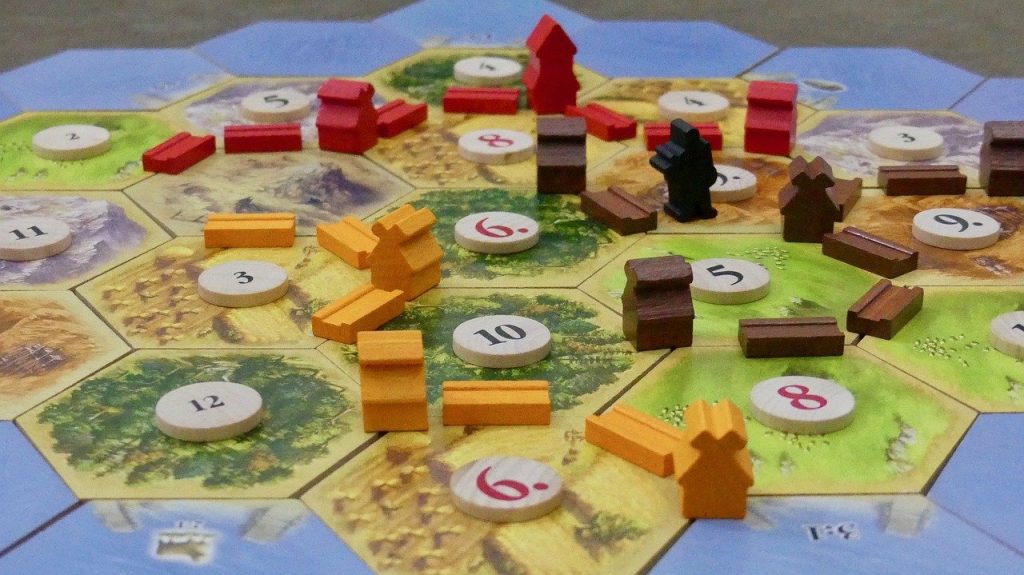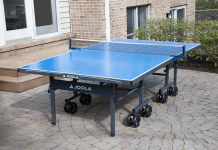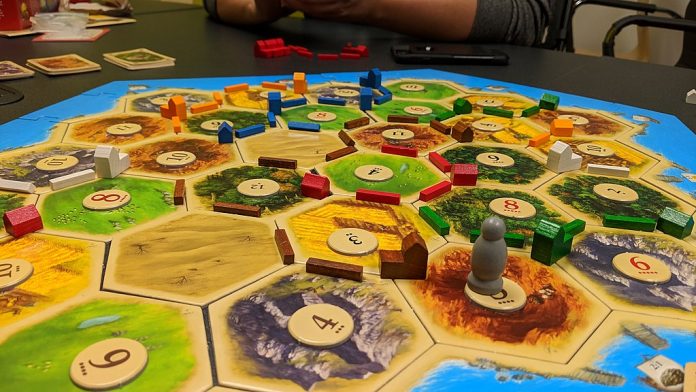The game of Catan burst on to the board game scene in 1995 and hasn’t looked back. It was one of the first European-style board games to take hold in the United States. This type of game prioritizes economics and collecting resources (think Carcassonne or Ticket to Ride). American-style games tend to prioritize direct conflict with other players (think Battleship). Its popularity has led to spin-offs and expansion packs and Catan is a staple at game nights. But wow, this can be a tough game to consistently win. Having a coherent Catan strategy can help greatly.
Don’t get me wrong – even on the few occasions I lose, I have a total blast. In a way it feels like chess in that I have to really think through what I’m going to do on every turn. For me, nothing is better than a game in which I have to think.
Table of Contents
My Love For Catan
Playing a thinking game is what makes this SO FUN for me to play with my 10-year-old. At this age, he plays what I call “brute-force” games. Simple card games like War and Go Fish, video games like Fortnite – games where you don’t have to have a huge overarching strategy (ones where the strategy guides on this website will be much, much shorter than this one).
I picked up Catan to play with him at the beginning of the pandemic. I had never played it before and it seemed like it would be fun to get some strategy games for him to learn. It seemed like Catan may be a little over his head but that it would be a good, fun learning experience for him. Thankfully I was right! He has loved learning to play and learning to have to think ahead to plan to win.
He’s learned a lot of my strategies I’ll be detailing below, such as the best locations for settlements, good strategies for dealing with trade offers (and making trade offers), and the best places to spend the resources you’ll be collecting.
Of course I haven’t taught him everything about my personal Catan strategy. I’ll teach him everything I know one day, but for now beating him is good practice for when I play against my peers (and it’s just fun for me to steamroll him at anything – he’s better than me at a lot of things so it’s rare that I can beat him!). Read on to find out the Catan strategies that I use, and soon you’ll be beating 10-year-olds and 40-year-olds alike.
Why a Good Strategy is Necessary
What is it about the game that makes having a solid Catan strategy so necessary?
First, as I said before – it’s like chess. Can you imagine saying “why would you need a chess strategy?” You’d be laughed out of whatever group you were in. This isn’t a simple card game like War where strategy isn’t required. With as many variables as there are in this game, you need to have some idea before you even sit down as to what you want to accomplish.
Second, this game has a lot of variables and ways to earn points. In Monopoly, you really have one way to earn money – buy properties and get rent. You can have different ways to go about doing that, but there aren’t multiple ways to get your opponents to go bankrupt. In Catan, there are plenty of ways to get Victory Points. Do you want to build a lot of settlements? Get the Longest Road card? You have to have a plan going in as to how you’re going to try to get those points, and how to make sure your opponents don’t stop you from accomplishing that goal.
Lastly, if your family or board game group is anything like mine, your games nearly turn in to fisticuffs. I am very competitive, as are my friends and family. I can promise you that if Catan makes it in to your game nights frequently, your opponents WILL have a strategy. If you don’t, you’ll come out on the losing end more than you care to. Keep reading – you’re almost to the good stuff. Here are my best tips to help build a winning Catan strategy.
Tips for Building Your Catan Strategy
In case you haven’t been able to tell so far, I love Catan. I actually kind of hated it the first few times I played – mainly because I hate to lose and didn’t have a plan to start winning. And let me tell you – I lost. A lot. Once I started to figure out the mechanics of the game and built a strategy, I started to win much more consistently. Keep reading to get in to my best tips to create your own unbeatable Catan strategy.
1. Don’t try to get access all of the resources at the beginning (play the high odds numbers instead)

Um, what?
Seriously. When you’re placing your cities at the beginning of the game, it is absolutely not important to make sure you place a city next to every resource. “But hey, writer guy,” I’m sure you’re muttering to yourself, “you need all of the resources in the game!”
Yes, that’s true. But it’s more important to play the odds of the dice rolls. You can get more resources by playing the odds of the dice than by making sure you’re connected to every resource.
This strategy also allows you to be very flexible in the game. If you have a sudden need or desire for a specific resource, you’ll have built up enough of another resource to trade for it. If you’ve spread yourself this so that your settlements are touching every resource, you may have to wait a while for something specific.
Dice odds
| Roll | Odds |
| 2 | 1/36 or 2.8% |
| 3 | 2/36 or 5.6% |
| 4 | 3/36 or 8.3% |
| 5 | 4/36 or 11.1% |
| 6 | 5/36 or 13.9% |
| 7 (resources not given) | 6/36 or 16.7% |
| 8 | 5/36 or 13.9% |
| 9 | 4/36 or 11.1% |
| 10 | 3/36 or 8.3% |
| 11 | 2/36 or 5.6% |
| 12 | 1/36 or 2.8% |
Given the choice, it’s typically better to place a building somewhere with a number that is more likely to be rolled (like a 5, 6, 8 or 9).
Related: Increase your odds of winning at Wits and Wagers
Example
Let’s say you’re placing cities at the beginning of the game and the only option you have to connect to a Brick hex is one where the dice roll to earn the bricks is 2. Statistically, you’re very unlikely to earn those bricks very often. Instead, place your towns close to hexes that have a higher chance of being rolled, no matter what the resource is. Those would be the hexes with a 6 or an 8 on them, or even a 5 or 9.
If you do this, you may build up a lot of the same resources. Maybe you have a town next to a Wood hex that pays off when an 8 is rolled. Soon in to the game you may have a dozen units of wood. That’s okay! Why? Because you can exchange 4 of those wood for any other resource. Or, if you’re next to a port, you may only have to trade 2 or 3 of those woods to get a new resource. You can also trade with other players, if they’re willing.
It’s better to build up resources that way and have to trade to get some resources than not earning resources at all.
2. Upgrade to cities as quickly as possible
It’s tempting to think that getting more settlements should be the priority. However, upgrading your starting settlements to cities should take precedence when you can.
Why would this make sense?
Think about placing your settlements at the beginning of the game. The players have already taken all of the best spots before anyone even rolls the dice once. So why prioritize taking over less-desirable spots? You can improve your standing much more quickly by upgrading your cities. This will let you double all of your resources when the right numbers are rolled, and then you can trade for resources even more quickly!
Once you’ve upgraded your starting settlements to cities, then you should start to worry about branching out to other locations.
Related: Strategies for Castles of Burgundy
Example
Here’s an example from a recent game I played against a friend of mine and my kid. My son was trying very hard to get as many settlements on the board as quickly as possible. The problem was that most of his settlements were connected to hexes with 2, 3, and 4 dice roll spots. So he’d spent all of his resources to build settlements, but then those settlements weren’t paying off with new resources.
Meanwhile, I upgraded my first two settlements pretty quickly. Both were connected to a hex with an 8 spot, and one of them was also connected to a 6 spot. So on a high percentage of rolls, I was earning two resources from each hex. At that point, it was easy to outspend him with my resources, while he wasn’t earning any of his own.
3. Don’t sleep on the Development Cards
The games in which I buy a lot of Development Cards, I win. The ones in which I don’t buy Development cards, I rarely win. Why would that be?
First, you’re most likely to be getting Soldier cards from that deck – that’s just the statistics of that deck. But that’s not bad at all. Each time you play a Soldier, you get to move the robber and steal from your opponents. Getting to use that robber by choice is great strategy. Also, the more Soldiers you play the more likely you are to earn the Largest Army tile at the end of the game, and that’s worth 2 Victory Points. Those two points can turn your game in to a quick win.
Second, even if you don’t get Soldier cards, all of the cards in that deck are very helpful. Many of the Development Cards get you a pile of resources that you can use for building. Some of the cards even give you a Victory Point directly, such as the University of Catan card.
Really, unless you’re just sitting on a huge pile of resources and you’ve already got the Largest Army tile, Development Cards are always worth spending the resources for. This is one of the most important parts of my Catan strategy.
4. Trade, then trade some more
You have to be willing to trade in Catan, unless you want the game to go on for hours like you’re playing Monopoly. This can certainly be in the form of exchanges to the bank at the 4:1 ratio (or, if you are connected to a port, 3:1 or even 2:1). But eventually, you’re going to have to trade with players.
My suggestion is to be nice early. Unless someone offers you a completely ridiculous trade within the first few rounds, I find it helpful to accept. It’s not going to hurt you in the long run – you have plenty of turns to earn those resources back. And it can help build good will with your opponents.
Also, make a few offers that are likely to be accepted. Don’t hurt yourself to do so, but if you can afford to offer a deal that is slightly bad for you, that also goes a long way towards building that good will.
Example
I have a friend who will decline every, and I mean every, trade offered to him. But then late in the game, he wants to offer trades to everyone and gets mad that they decline just like he does. Why would I want to trade with someone who won’t even listen to my offers? Sometimes I decline a trade he offers me just on principal late in the game, because he hasn’t wanted to listen to my trades before that.
But my son? He’ll trade with anyone, all the time. So when he comes to me with a trade I’m much more willing to listen and negotiate. His willingness to be a trade partner early in the game makes me much more likely to want to work with him later.
5. Get thee to a port
I said earlier that building new settlements shouldn’t be a priority early in the game. However, eventually you’ll likely need to build at least one or two new settlements. When you do so, I highly suggest making your first new settlement a port.
This really goes along with my trading advice above. You can trade 4 resources to the bank for any 1 resource that you need if you don’t have access to a port. But if you do have access to a port, that trade ratio goes down to 3:1 for one of the “trade in any resource” ports, or even 2:1 for one of the “specified resource” ports.
The 3:1 ports are great if you aren’t sure which resources you may have the most of later in the game, while still reducing how many resources you have to give to the bank when you choose to trade. The 2:1 ports are good if you can look at the board and know exactly which resource you’ll have a lot of.
This allows you to trade for any resources you need while saving as much of your resources that you’ve already earned. It’s almost like picking up perfectly good resources on the clearance rack.
6. The Longest Road card
This is the most sought-after item in the game in my family, and for good reason. Aiming for the Longest Road card is very smart strategy.
First and foremost, the card is worth 2 Victory Points. Earning this card early is a great head start to getting to the necessary 10 Victory Points. It’s also usually pretty easy to defend. You can see your opponents building roads and can see if their aim is to take over the card. Continuing to build roads as they do makes it hard for them to take over the card.
Second, this is smart strategy outside of actually earning the card. Any new settlement has to be built on a road, so building long roads in desirable places can block your opponents from being able to put settlements there. So not only does that get you the two Victory Points for the Longest Road, but it might also stop your opponents from getting Victory Points by building more settlements.
Related: Exploding Kittens strategies for victory
7. Monopoly!
I know, I know – this article is about Catan. But holding a monopoly is a good idea in this game too, if you can manage it.
Let’s think about Bricks. You need them to build roads, so they’re an important resource. There are only 3 hexes that earn you Bricks (compared to 4 for lumber or grain, for example). At that point, look at which one is most likely to be rolled. If the 3 Brick hexes have chits for rolls of 8, 4, and 2, for example, try to build your settlements around that Brick hex that has the 8. Since any settlement has to be at least 2 “spaces” away from any other settlement, it just takes 2 settlements to essentially monopolize that Brick hex.
What good does that do?
It means you’re likely to be the only one that consistently has that resource. The 4 and the 2 in the above example are unlikely to be rolled very often, while your 8 should be rolled reasonably often. If you’re holding a lot of Bricks and everyone else has to struggle to earn bricks, you’re going to be in a very good situation.
This will allow you to more easily build roads (see my advice about the Longest Road above), and also make sure that your opponents can’t build those roads. At least, unless you let them. You’ll be in a great position to demand high trade value for those bricks. You want 4 grain for 1 brick? Great! You can make those types of demands if you’re the only one holding bricks.
8. The Robber
This is always the wildcard in any game that I play. Things can be going along so well when suddenly your best opponent rolls a 7 or throws down a Knight card. This allows them to play The Robber. There are three aspects to any activation of The Robber:
- Any player with 8 or more resource cards must give half of them back to the bank.
- The player who activated The Robber moves the token to any resource hex. As long as The Robber is on that hex it will not produce resources for the settlements or cities adjacent to it.
- The player who activated The Robber can steal 1 resource from 1 player who has a settlement or city on the hex that they moved The Robber to.
So, looking at the rules, there is a lot to think about. First, look at your own resource stack. Don’t play a Knight card if you’re holding 8 or more resource cards, as you’ll have to give half of them back (yes, this applies to you too!)
Second, you have to think about where you’re going to move The Robber. My suggestion is a hex with either a 5, 6, 8, or 9 chit, as they’ll be more likely to give your opponents resources, which you’re trying to stop by using The Robber.
Lastly, you have to think about who you’re going to steal from. If one of your opponents only has Grain and you don’t need Grain, maybe look at another hex to block. Do your best to steal from someone with resources that you actually need.
Strategy Summary
There is a lot going on here, I know. But for a game with so many different ways to earn Victory points, there are a lot of different ways to try to win.
It starts with game setup and making sure you strategically place your settlements. Make sure you place your initial settlements in a place where they’ll earn resources – any resources. Don’t waste these settlements by placing them in areas where they won’t earn anything. Then turn those settlements in to cities as quickly as you can so that you’ll double the resources that you’re earning.
Then use all of those resources to build the Longest Road and to buy Development Cards. This will turn those resources directly in to Victory Points that you can use to win the game.
Speaking of resources, monopolize one resource if you can. That puts you in position to be demanding in trades. And you definitely should be trading often, whether that’s with your opponents or with the bank. And since you’ll likely be trading with the bank often in the game, make sure you have a port so that you can reduce your trade costs. This makes sure that you can obtain the resources you need to follow the rest of your strategy and win the game.
Building out a solid Catan strategy using some of the tips above, if not all of them, should definitely help you start winning your Catan games more often. Good luck!

Veronica is a Green Bay-based freelance writer and editor with extensive experience with board games. When not busy scribbling her thoughts, you might find her in her garden, hiking out in the woods, or exploring new food joints.
Veronica is a die-hard board game and chess hobbyist by night. She likes to try out new games and is always on the lookout to recruit new players for her game night (so beware!). When not playing board games or throwing darts, she is usually busy painting miniatures (or doing other nerdy stuff).
She is the CEO & Content Writer of Indoor Games Zone. She shares her expertise from years of playing chess, board games, and darts.

![Stiga XTR Pro Review | 1,559+ Global Ratings (In-Depth Guide) [year] Stiga XTR Pro Review](https://indoorgameszone.com/wp-content/uploads/2021/08/Stiga-XTR-Pro-Review-218x150.jpg)







